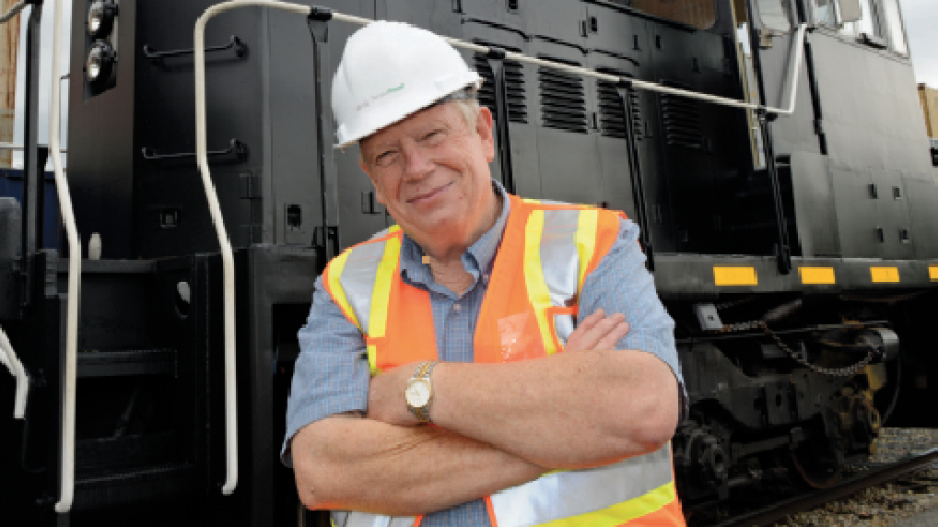A B.C. innovator who developed low-emission locomotives only to lose the company he co-founded to bankruptcy in 2009 is staging a comeback.
Frank Donnelly, who co-founded Railpower Technologies Corp., has a new company called Tractive Power Corp. that has built a mini-locomotive designed to be a durable, fuel-efficient, low-emission alternative to what is currently used at ports, grain elevators and railway yards throughout North America to move railway cars around.
A prototype, called the TP56, is in use at the Parrish and Heimbecker Ltd. grain terminal in Cloverdale.
“This product that we’ve built, we’ve gone back to basics,” said Donnelly, who admits Railpower Technologies’ bankruptcy five years ago was a setback.
“There was a lot of reflecting,” he said.
Founded in 2001, Railpower developed a number of low-emission locomotives. One was a hybrid that used both diesel power and batteries; another had multiple diesel engines, which could be turned on and off according to the power demands.
But the goal behind all models was the same: reduce fuel consumption and emissions from locomotives in ports and railway yards.
At the time, government incentives designed to encourage industry to move to cleaner technology boosted sales, especially in California and Texas. At its peak, the company employed 160 people.
But just as market-distorting incentives led to oversaturation and bankruptcies in the solar power market, Railpower also fell victim to market oversupply.
“We had competition in rail power and I think we kind of saturated the market,” Donnelly said.
In 2009, the company was forced to file for creditor protection and its assets were acquired by Kentucky-based R.J. Corman Railroad Group, which still sells the locomotives Donnelly designed through its subsidiary, Railpower Technologies.
Donnelly said there is still a good market for fuel-efficient, low-emission machines to move railway cars around in industrial yards. At $750,000 each, the TP56 will be competitive, he said.
There are new incentives for industrial operators in Vancouver to switch from older, dirtier locomotives to something less polluting, which is one of the reasons Parrish and Heimbecker is leasing the TP56, with an option to buy.
In 2012, Port Metro Vancouver enacted a new bylaw aimed at curbing pollution from “non-road” diesel engines, and older diesel locomotives are one of the bylaw’s targets.
“Older rail locomotives have been a concern because of their poorer emission standards and the tendency for older engines to be removed from line haul service and redeployed to railway switch yards,” said Metro Vancouver spokesman Bill Morrell.
“These switch yards are often in closer proximity to where people live, work and play in our region, hence the concern about more people being exposed to higher levels of diesel particulate matter. Unnecessary idling of these engines adds to this concern.”
When railcars are dropped off in a yard, there are generally two options for moving them around. Some companies will use full-scale locomotives – usually older “castoffs” that may not meet new emission standards.
The other alternative is railcar movers, some of which can run either on rails or on wheels.
“With the railcar movers, they’re great except that they’re not very durable,” Donnelly said. “They last typically about six years and they’re extremely high-maintenance and there are issues with performance.”
With the TP56, Donnelly hopes to fill the gap between the full-scale locomotive and railcar movers.
“This locomotive will probably run 20 to 30 years without much problem, whereas because of the way railcar movers are built, they typically go about six years before they need a full overhaul,” Donnelly said.
One of the advantages of the TP56 over the Shuttlewagon railcar mover that Parrish and Heimbecker needs to replace is its weight, which gives it better traction, said Dustin Stewart, production manager for the Parrish and Heimbecker Cloverdale terminal.
“It’s obviously a lot lighter than a locomotive, but you have the weight-to-track ratio,” Stewart said.
The grain terminal’s yard has a 3% grade, so it needs something that has good traction – enough to pull up to eight cars – but which also meets Metro Vancouver’s new emission standards for non-road diesel vehicles.
Since the TP56 is half the length and weight of a full-scale locomotive, it burns a lot less diesel, but it still has sufficient weight to provide better traction than many railcar movers.
“Our locomotive, at idle, burns about 1.3 litres per hour and the smallest locomotive available burns six to seven times as much fuel at idle,” Donnelly said.
“It is not revolutionary. It’s a simple, basic unit meant to be robust, low-maintenance and kind of like the Energizer bunny – just keep going.”




